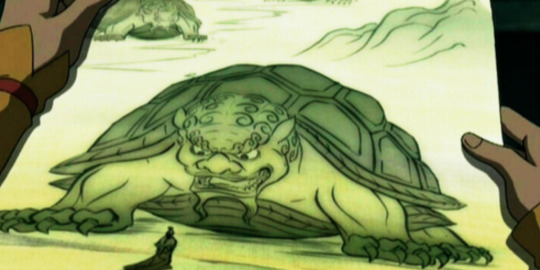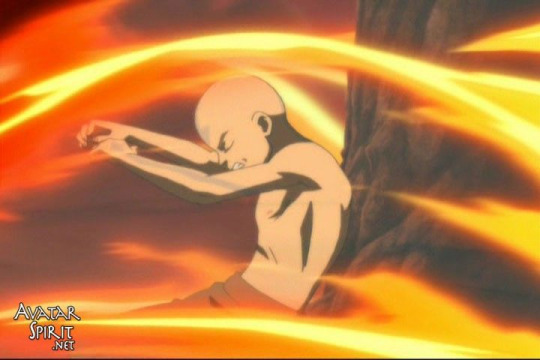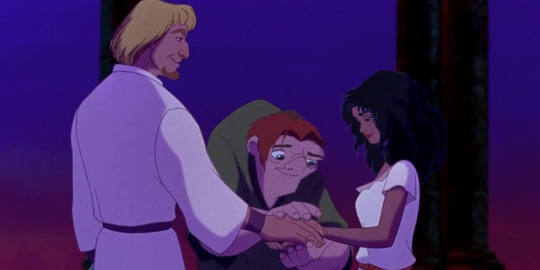#we accept that the writers wanted to keep the mystery so how zuko even knows to go there is hand-waved to not give away the surprise
Text
I know this isn't going to have any effect on those who feel justified in hating the adaptations they do - all sorts from comic to screen, book to screen, animated to live-action - but in my re-watch of ATLA (animated), I've noticed a lot more 'eeehhh' storytelling than I did in my other watches. Because I'm looking for it to compare specifically how they did it in the animated to how they did it in the live-action.
And let me tell you - the animated story is amazing, phenomenal, one of my favorites ever...and it has storytelling issues.
So maybe, if you were convinced the PJO adaptation was shit, the ATLA adaptation was awful, the Wheel of Time show was a tragedy, try going back and watching/reading the OG LOOKING for things to gripe about. Treat the OG like you treat the adaptation - with the most critical eye for any inconsistency, character work you don't like, plot holes, expositional dialogue, and pacing issues.
LOOK for those issues, and I guarantee you'll find them. Because, let me let you in on a secret: no story is perfect. We love them anyways because the story is still good. It's still meaningful. It still has merit.
Imagine the OG is actually the adaptation and (if you're able to honestly do that) you'll find things the adaptation did better.
Again, I know the people who've made it their personality to hate all adaptations and pretend they're storytelling geniuses who know best aren't going to pay attention to this, but idk, maybe one person will? Or for us more forgiving watchers, we'll be able to catch ourselves if we start to make some uncharitable, knee-jerk arguments about certain pieces of media.
Idk, just try it maybe.
#fandom#adaptations#pjo tv show#atla netflix#wheel of time on prime#just something to think about before you get all righteous in your indignation over an adaptation#like I'm watching the blue spirit episode of atla and...yeah...how zuko is up on the roof when zhao gets his promotion?#how did he know Zhao had even captured Aang or where he was keeping him?#it literally makes no sense yet we forgive it because it's a dope episode#we accept that the writers wanted to keep the mystery so how zuko even knows to go there is hand-waved to not give away the surprise#but you can bet your ass if it was explained in the anime and the live-action hand waved it - HOO BOY would people be lambasting it#so many criticisms would be made of OG storytelling if the changes in the live-action v OG were reversed
11 notes
·
View notes
Note
Do you have thoughts on the Aang/Ozai showdown at the end?

Zuko: please. The real hero is a random rock the Avatar.
The final battle was amazing, from an animation poin of view. The colors, the fighting sequence, the symbolism, Aang finally mastering all elements. Just very exciting and satisfying to watch, because it was something that the audience was hoping for since episode one. And they delivered it.
From a writing point of view, though? It was less of a showdown and more of a cop-out. See, I'm not saying, by any means, that Aang should have killed Ozai. Quite the opposite. Not only because it was a children's show. Not only because Aang was a traumatized, non violent, 12 years old. But also because it made sense for the character and for the core themes of the show.
Don't get me wrong, Ozai one hundred per cent deserved to die. Aang himself stated that the world would be a better place without Ozai in it. I just don't think he should be the one to do it. At the same time, is on his hands that Ozai's fate lays and no one else can make that decision for him.
So if killing Ozai off could turn him into a Fire Nation martyr anyway and Aang refuses to do so because of his pacifist principles, what's the other option to defeat the guy and end the war? The authors went with energy bending and, honestly, I thought it was brilliant for a series of reasons.
First, ending Ozai's life seems like the obvious choice, an easy way out. I love the concept of Aang refusing to do what's expected of him and choosing instead to finish the war on his own terms, without compromising who he is, because in theory, that would mean he would have to go out of his way to find a different solution, in a perfect shout out to Bumi's words in The King Of Omashu: "you must master the four elements and confront the Fire Lord. And when you do, I hope you will think like a mad genius."
Second, in a show where bending is intimately related to one's very being, the questions begs to be raised: how much taking someone's bending away is better, more ethical or less cruel than actively killing them? Because it's a fundamental part of who they are, of their soul. Ty Lee had the abiliity to block chis, temporarily making people unable to bend. And it was a terrifying thing for the people she used the technique on.
Lastly, it ends the "killing Ozai would turn him into a Fire Nation martyr" for good, because (ATLA COMICS SPOILER ALERT) Aang let him leave without his bending and a significant amount of people still worshipped the guy to the point of planning coups on the down low and sending Zuko death threats left and right, so we basically got the same result, but Ozai remained an ever present threat to the peace Aang fought to achieve.
The problem, as people smarter and more eloquent than I have pointed out countless times, wasn't the energy bending solution, it was the way it was introduced and then executed.

Aang: hey! Look at these weird Lion Turtle things.
Looking back now, this scene from The Library was obviously foreshadowing the finale, so the Lion Turtle reveal wasn't pulled out of thin air. It had a purpose. Considering that this episode, from Book Two, mentioned the Lion Turtle, who would later teach Aang how to energy bend and that The Guru, also from Book Two, introduced the arc of Aang having to let go of his attachment to Katara in order to master the Avatar State, I can only assume that the original intentions of the writers were very clear:
Aang doesn't want to kill Ozai but he also doesn't want to let go of Katara. That's the catch! To "energy bend" his way out of murder, he has to master the Avatar State. His conflict here, is much greater than before because now Katara is a factor in the equation as well. He either kills Ozai, keeps his attachment and gives up the Avatar State or he masters it, defeats Ozai by removing his bending but has to let go of Katara in the process. It's awesome because it's the hardest possible choice a character like Aang could be forced to make. And we knew he would ultimately do the right thing, but regardless of what he decides, he still loses something important to him, he still has to make a huge sacrifice.
Of course, none of that happens. This was the first and only time the Lion Turtle was brought up. The “letting Katara go” arc was unceremoniously killed alongside Aang the second Azula shot that lightning in Ba Sing Se, but differently from the Avatar, whom Katara ressurrected, it was never brought back. And it’s a shame. Because The Library was the perfect episode to expand on the Lion Turtle and energy bending mystery.
And the finale? It was the perfect episode for Aang to do what he failed to do in Ba Sing Se: to let Katara go and achieve the Avatar State by his own merits, sacrificing something he wanted for the greater good. The way he hid into a cocoon of rocks? It would have been a great call out to the little crystal tent he made in his fight with Azula when he decided to give the Guru’s advices a try. And it would also symbolize rebirth in the same way Katara breaking him out of the iceberg did. Because now he had finally reached the other side of the river and he is no longer the same person he once was.
But the narrative decided, instead, to rob Aang from any growth, from any substancial change, from any interesting arc. They went with the “love is the most important thing” approach to justify him honlding on to Katara. And I could have bought it if they hadn’t been so dishonest about it.
First: if you love someone, you let them go. Attachment and love are two very different things. No one ever told Aang to stop loving Katara. He was told to let her go. And it makes sense because he was attached to her in a way that wasn’t healthy for either of them, and was keeping him from achieving his full spiritual potential, something he should care a little more about, given his upbring.
Second, in the person of Iroh, arguably the wisest character in the show, Aang is told that he is right for choosing love over power. But this is a false equivalence because it’s not what Aang is doing. The scene makes it look like he is seeking power for the sake of power. That’s not the case. The Avatar State is an inherent power, meaning Aang already has it. It’s part of who he is. He just needs to unblock it and learn how to control it. And he has to do that not for personal gain, but to put an end in the war.
A war that took almost everything from Katara, the person he loves. Aside from Aang himself, she is the person who would benefit the most from him learning to control the Avatar State, since she is the one who has to calm him down every time he accidentaly triggers it and winning the war is a very personal goal of her. Now, this is just conjecture but I firmly believe that even if Katara was secretly in love with Aang (which I don’t buy), she would be the first to tell his it’s okay to let her go. But alas, she wasn’t even aware of this conflict. A conflict she played a key part in.
That being said, I do think that the Ozai dillema was introduced too late. It should have been explored before the Day of Black Sun, giving Aang plenty of time to search for a different solution. It also never made sense to me why killing Ozai wasn’t a problem then. Apparently the explanation that I was supposed to stick with is that Aang was naive. He didn’t know people expected him to kill the Fire Lord until Zuko asked him what he would do when he faced Ozai, since violence wasn’t the answer. But I honestly struggle to accept this because, yes, Aang was naive.
But not that naive. Not at that point. After episodes like The Siege of the North and The Avatar State, I just don’t buy he didn’t know what people wanted him to do. Plus, Aang has an evasive fighting style, based on always being one step ahead of his opponent. To do that, he has to plan beforehand. What was his plan to confront Ozai in the Day of Black Sun, after everything he went through? Talk to him? Arrest the guy? If that’s the case, shouldn’t it at least be discussed with the gang? It’s never addressed.
Then comes the finale. Aang’s moment of truth. The event we’ve all been hoping for. The one that will turn him into a legend. And Aang is losing. He can’t win without killing Ozai or controling the Avatar State to take his bending away. What will he sacrifice to become a hero? His morals or his attachment? Answer: neither! Because the writers decided he should have everything without give up nothing. So they miraculously make a convenently sharped rock hit the exact right spot in the perfect time unblock his chakra, allowing him to enter the Avatar State.

I’m not even gonna talk about how this is most definitely not how chakras work, because it’s not really my place. But I am gonna talk about the tragic (not to say hilarious) fact that, by trying to make Aang have his cake and eat it too, the writers ultimately made a fucking rock the responsible for Aang’s success. Not his cleverness, not his hard work, not his altruism: a rock. If that rock wasn’t there, in the right place, at the right time, then what? Would Aang finally have done what he had to do, or would he be killed, allowing the war to continue?
That’s my issue with it. That, and the fact that they had no trouble addressing delicate topics, but didn’t have enough courage to let the 12 years old protagonist end up alone. Because, of course, children can’t understand the hero not getting the girl. Right?

RIGHT?
Aang managed to defeat Ozai and get the girl even though there was a whole season dedicated to build up an arc in which he would have to let her go to succed. Even though their last one on one interaction before their last kiss was Aang screaming at her and storming off, while Katara reprimended him for walking away from the issue. Even if he had been acting more and more possessive and entitled when it came to her affection. Even if Katara had shown no real interest in him that way before she suddenly does. But what do I know? Maybe she was hit by a magic rock too.
Aang and Katara happened at the cost of Aang’s character development. Fandom might think the rival ship was harmed the most by it, but that’s not true. Aang was. And it’s really sad. He is an amazing character and he deserved to be the hero of his own story, to have his beliefs tested and to come out of his journey irrevocably changed, not locked inside a plot armor.
10 notes
·
View notes
Text


When Nico Robin first turns up on the ship, Oda knows he has do something to get the reader on board with her joining. And it would be so easy for him to just give her a tragic backstory and be done with it, but he goes a different route. He immediately introduces a mystery to show off her usefulness to the crew, and this is crucial to doing a redemption arc.
Because let’s be real, a sad backstory doesn’t mean much if we don’t care for the character. They aren’t real people, and expecting the audience to have sympathy for them in the way we have cursory sympathy for real people ain’t gonna work. But what if you start a bad guy/girl’s redemption by making them useful? What if the protagonists need this character because only through them can the goal be achieved? Well then wouldn’t the audience, no matter how much they dislike the baddy, tolerate them for as long as they are useful, thus giving the writer time to build an emotional connection?
Thinking about it, characters like Zuko or Vegeta or Emma Frost work through this method. They all have tragic backstories, sure, but before the audience is asked to welcome them to hero’s team, the characters must first prove their usefulness. Even if their past is shown before that point, it is really only meant to have us understand their motives, instead of tell us, “see this character is a sad boi, so you should want them to be good.” Zuko rescues Aang as the Blue Spirit. Vegeta teams up with the Z warriors against Freeza. Emma helps out with Phalanx and trains Generation X. All these characters contribute significantly before they (officially) join the good guys, and Robin is no different here. We may not accept her into the Straw Hats yet, but throughout Jaya, she keeps providing support to the group that helps us tolerate and slowly relax around her.
I just also really love that Robin’s skills as an archeologist are so important here. After the Skypeia Saga, her archeology only applies to Poneglyphs, so these two pages are unique. I guess Oda can only write so much archeology stuff in his adventure manga before accusations of being an Indiana Jones rip-off start.
#One Piece#Nico Robin#writing is hard#Vegeta#Zuko#Emma Frost is Queen#Skypeia is my favorite arc#characters aren't real people
10 notes
·
View notes